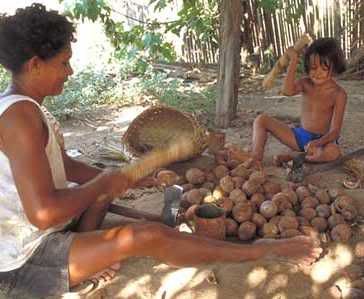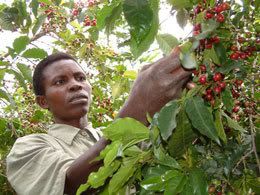Father of bio-jet fuel launches biofuel cooperatives in Brazil to reduce poverty

At 66 of age, doutor Expedito has never been so requested. His 'bioquerosene' (biokerosene) should be a way to reduce carbon dioxide emissions in aviation and to prepare for a gradual substitution of jet fuel. Parente's fuel was courted by both NASA and Boeing. Tests have been performed since mid-2006 and are believed to soon enter a decisive stage at Boeing’s facilities in Seattle. Contrary to bioethanol and biodiesel already established in road transportation worldwide, biojet fuel is a vegetable product which has still not been in commercial use.
For a long time, Expedito Parente (left in the pic) was a professor at Ceara Federal University in Fortaleza, a large city in Brazil’s Nordeste region. When he retired, this hyperactive academic wanted to continue to do something useful. In 2001, he thus founded Tecbio, a small engineering firm developing biodiesel refineries. It was nicely timed. Tecbio has now a staff of eighty and is growing exponentially. But Dr. Parente nourishes a double obsession: to be the first to make airlines adopt bio-jet fuel, an important technological step ahead of ordinary biodiesel, and producing this biofuel in Brazil in a socially correct way.
Babassu palms
 In 2005, professor Parente won the Blue Sky Award for his aircraft fuel project, "a kind of Nobel prize given by the UN for innovations in the field of renewable energies", he comments.
In 2005, professor Parente won the Blue Sky Award for his aircraft fuel project, "a kind of Nobel prize given by the UN for innovations in the field of renewable energies", he comments.Interest for the invention was confirmed at the beginning of this year at a Washington D.C. seminar organized by the Transportation Research Board, a government agency. Participants were confronted with an apparently absurd question: "May Babassu already be a renewable source to serve as substitute for jet fuel?"
This palm tree, unknown to most people in the West, grows in the wild on 18 million hectares (45 million acres) in Brazil's forest in the North East. Such size corresponds to six times Maryland or roughly half the size of Switzerland. It was Expedito Parente who discovered that the nuts of the babassu - or more precisely the kernels within - can be turned into an oil that possesses energetic properties which make it an ideal feedstock for bio-jet fuel.
There are certainly social and ecological arguments in favor of the babassu palm: its use does not compete with land for food production, nor does it imply deforestation as the palm grows in the wild and can thus be integrated in sustainable agro-forestry systems (earlier post):

bioenergy :: biofuels :: energy :: sustainability :: babassu :: biodiesel :: biokerosene :: bio-jet fuel :: poverty alleviation :: agro-forestry :: cooperative :: Brazil ::
Professor's comeback
In reality the discovery is not all that recent and babassu has been growing in Brazil for ages. But Professor Parente himself is making a spectacular comeback. In the 1980s he was the first in the world to patent biodiesel as an industrial process. He was acclaimed as the “Father of Biodiesel”. This brilliant academic was then asked to find a vegetable substitute for aircraft fuel. The product resulting from this research made a turboprop transportation airplane fly a distance of some 600 miles in 1984. So why did not aviation worldwide adopt his biokerosene? Parente explains:
At the time, petroleum prices went down dramatically. And we must understand that a fuel to be acceptable for modern jetliners has to be extremely reliable and resistant at very low temperatures, it is a complex product.There is a new dimension to what is at stake. To fly from London to Rio, and back, provokes individually as much CO2 emissions as those generated during fifteen months of sedentary life in a European capital, heating and local transportation included, if we are to believe comparative studies of environmental impacts. Already, air transportation operators supply travelers with different service contributions to buy, in compensation for greenhouse effect emissions.
Globally, airlines gulp down 26 billion gallons of fuel per year, and this figure may double in twenty years. 20 per cent of their operational costs correspond to fuel. For the first time in 2006, the fuel bill exceeded costs for staff in the sector. Sir Richard Branson, British business mogul, scorching supporter of many environmental causes, but mainly founder and president of the Virgin group which counts several air transportation carriers, said in a recent interview that "immediate solutions" should be found (earlier post).

Eco-taxes
Today, biojet fuel does not seem to be entirely competitive though, as jet fuel derived from petroleum is sold free from taxes at 1,5 USD per gallon, which is still very cheap.
Soon there will be eco-taxes on aviation fuel. And I am pretty sure that authorities will make it mandatory to blend conventional fuel with biojet when available. Costs will also shrink significantly when industrial production is started.But won't the land areas needed be gigantic? Doutor Expedito has a ready answer:
If 20 per cent of aviation fuel were to be produced in form of green fuel for blending, such volumes would correspond to some 30 million acres land. It’s a huge territory, I agree, but it is less than the existing Babassu forests.Cooperatives
Tecbio and its involuntarily hype boss have furthermore a very clear social vision. This is important to emphasize, as bioethanol mills using sugar cane as raw material has not reduced poverty in the Brazilian countryside. Seasonal plantation workers called boias frias (“cold billies”) have a hard time. Because of piece-work, a Brazilian cane cutter will only ‘last’ twelve years, less than a slave in ancient times, according to a recent study.
Professor Parente gets upset:
Such conditions are intolerable. We have our own model which pretends to reconcile social development and industrial dynamics. At present date, Tecbio is leading two pilot projects in collaboration with federal authorities. The idea is to create cooperative units, in association with the local population, for a socially correct production of biodiesel derived from Babassu kernel oil. Respecting the environment, this model should be replicated in other regions, for examples in deforested areas of the Amazon and in Africa.But is it not utopian wanting to assemble two operational methods which are normally dissociated: the small-scale traditional way versus output through high-tech plants ? Expedito Parente holds out his arms. He makes one think of a talented film maker who, after years of prospecting, has just received unlimited funds to shoot an ambitious picture based on an art script:
One has to be pragmatic. We work with feasibility from an economic point of view. Running a cooperative does not mean that it should not be profitable. In a basic scheme, each cooperative shall produce three million liters [800,000 gallons] of biodiesel/biojet fuel per year, together with several other products originated from the nuts. There will be some agriculture. All the electricity consumed in the cooperative shall be generated organically on the spot. Each cooperative is giving part-time jobs to 3,000 peasants. On the other hand we study also ecologically run Babassu plantations.To produce one billion liters of biojet fuel, [270 million gallons] at least 300 such cooperatives are needed. This is certainly a time-consuming project. Plans are allowed to be extensive though, changeover seems to be secured. Of four children, Doutor Expedito has one son working at Tecbio. At age 26 and a chemical engineer as his father, he already takes part in management. His name is premonitory : Expedito Parente Junior...
Copyright, Agoravox, 2007.
Article continues
 --------------
--------------
 A 7.1MW biomass power plant to be built on the Haiwaiian island of Kaua‘i has received approval from the local Planning Commission. The plant, owned and operated by Green Energy Hawaii, will use albizia trees, a hardy species that grows in poor soil on rainfall alone. The renewable power plant will meet 10 percent of the island's energy needs.
A 7.1MW biomass power plant to be built on the Haiwaiian island of Kaua‘i has received approval from the local Planning Commission. The plant, owned and operated by Green Energy Hawaii, will use albizia trees, a hardy species that grows in poor soil on rainfall alone. The renewable power plant will meet 10 percent of the island's energy needs.


 Developing and designing innovative biorefinery concepts to make biomass-derived products cost-competitive with fossil fuels is the goal of the EU's newly launched
Developing and designing innovative biorefinery concepts to make biomass-derived products cost-competitive with fossil fuels is the goal of the EU's newly launched  A refreshing
A refreshing  Cuba is quietly modernizing its ethanol-producing facilities, despite Fidel Castro's repeated assertions that making more of the biofuel is a bad idea. Hypocrisy or not, the fact is simple: Cuba has the capacity to become a major ethanol producer, and it will not hesitate to take advantage of the opportunity. Earlier we reported on how the emerging biofuels market may revive the island's once thriving sugar industry (
Cuba is quietly modernizing its ethanol-producing facilities, despite Fidel Castro's repeated assertions that making more of the biofuel is a bad idea. Hypocrisy or not, the fact is simple: Cuba has the capacity to become a major ethanol producer, and it will not hesitate to take advantage of the opportunity. Earlier we reported on how the emerging biofuels market may revive the island's once thriving sugar industry (







Friday, May 25, 2007
Researchers study effectiveness of glycerin as cattle feed
Along the same lines, researchers from the University of Missouri-Columbia are now studying whether glycerin can be used to feed cattle. In a study that began this month, Monty Kerley, professor of ruminant nutrition in the College of Agriculture, Food and Natural Resources, is examining the effectiveness of glycerin as component in cattle diets. Through November, the MU researcher will monitor the growth habits of 60 calves from various breeds to determine if the leftovers provide a healthy main course to cattle. The study has two main priorities: first, to determine if glycerin has a positive or negative effect on calves' growth performance, and second, to assess its impact, if any, on meat quality.
The cows have been separated into groups of three, each consuming differing amounts of glycerin during their daily diet. The amounts are 0, 5, 10 and 20 percent. In addition to monitoring feeding limits and growth patterns, Kerley also is analyzing how cattle metabolize the varying amounts of glycerin. Unlike the dry feeds they are accustomed to eating, Kerley said the glycerin is liquid based and comes mostly from the processing of soybean oil. He also said it meets stringent Food and Drug Administration regulations:
"We're really looking at the energy value and how it compares to corn," Kerley said. "When the animal consumes glycerin, it's absorbed, and the glycerin is used to make glucose. Actually, it's like feeding sugar to a cow. Because it's liquid, there are two things we worry about - one, how much can be used in the diet before it changes the form of the diet; and two, is there a limit to how much glycerin can be processed by the animal? We'll feed it to them for a period of 160 to 180 days."
Kerley said developing usages for glycerin necessitates this type of research. In recent years, academic scientists and private-sector companies have been racing to find solutions and applications for the byproduct. An alternative food source for cattle is but one possibility. However, it's likely only a short-term option for the cattle industry.
"We probably have a three- to five-year window to use this for animal feed at a reduced cost," Kerley said. "This glycerin is a wonderful starting compound for building other compounds that can be applied to numerous industrial purposes. After three to five years, you'll see industrial applications utilizing this glycerin, and that may price it out of the animal feed industry."
He said economics are another factor because glycerin is currently less expensive than corn, which is most commonly used as cattle feed. Glycerin is about 4 cents per pound; corn costs around 8 cents a pound.
"Originally, the biodiesel plants were concerned with just getting rid of this material, but data shows that glycerin has energy feed value equal to corn," Kerley said. "If you can get glycerin for less than corn, that's obviously a sizeable savings."
Image: biodiesel production is achieved by transesterifying vegetable oils. Glycerin settling at the bottom of a batch of biodiesel. Biodiesel production results in a fraction of 10% glycerol, making it an important byproduct.
Article continues
posted by Biopact team at 8:23 PM 0 comments links to this post
